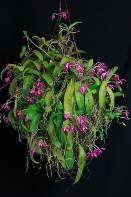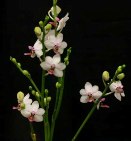Phalaenopsis Culture
Light
 Phalaenopsis are somewhat low light orchids, they will grow and flower reliably in natural or artificial light. An east window (south or west if shaded or through sheers) should be just about right. Phals can be happy inside year round; they may be put outside in very shaded area, or even a Florida room or lanai, provided they do not get wind-whipped or too cold. A good tip: The new leaf growth should be equal to, or larger than older growth.>
Phalaenopsis are somewhat low light orchids, they will grow and flower reliably in natural or artificial light. An east window (south or west if shaded or through sheers) should be just about right. Phals can be happy inside year round; they may be put outside in very shaded area, or even a Florida room or lanai, provided they do not get wind-whipped or too cold. A good tip: The new leaf growth should be equal to, or larger than older growth.>
To test for the correct light level, place your hand between the source and the phal. If the shadow of your hand is fuzzy or indistinct, then the light is sufficient. If the outline of the shadow is sharp, then the light is too bright. If introduced to the brighter conditions gradually, Phalaenopsis can be grown in higher Cattleya light but not for long periods of time.
For phalaenopsis, only some very filtered morning sun until 10 am may be tolerated, but protection from the sun after that time is necessary. Unless protected, during the hottest part of the day, the flattened leaves will easily burn. Lime green colored foliage is an indication of too high light. In phalaenopsis, medium to solid green foliage is indicative of the perfect light. Yellow colored foliage indicates too much light or too much water.
Water
 Phalaenopsis enjoy watering year around, and do not have a yearly rest period. Like their vandaceous cousins, phals have only their leaves and stems to store water. Phals like to be a little moist, at their roots, but never soaking wet. The foliage must stay dry, or you invite possible rot problems. The frequency of watering is relative to the container, the temperature, air circulation, and the amount of water retained in medium in the container. Watering should be done so the roots are just allowed to dry out. In the warmer or dry periods, several waterings a week may be necessary. Close watch must be maintained to avoid soggy conditions in the pot leading to root rot. When in doubt about when to water, wait another day or two. Check the pot by sticking your index finger down the inside of the pot. If it feels damp half way down, wait another day or so. Never use salt softened tap water.
Phalaenopsis enjoy watering year around, and do not have a yearly rest period. Like their vandaceous cousins, phals have only their leaves and stems to store water. Phals like to be a little moist, at their roots, but never soaking wet. The foliage must stay dry, or you invite possible rot problems. The frequency of watering is relative to the container, the temperature, air circulation, and the amount of water retained in medium in the container. Watering should be done so the roots are just allowed to dry out. In the warmer or dry periods, several waterings a week may be necessary. Close watch must be maintained to avoid soggy conditions in the pot leading to root rot. When in doubt about when to water, wait another day or two. Check the pot by sticking your index finger down the inside of the pot. If it feels damp half way down, wait another day or so. Never use salt softened tap water.
Fertilizer
 Fertilizer helps your plants. It is good to fertilizer at least every 2 to 3 weeks. We recommend fertilizing ¼-½ teaspoon per gallon of water each time you water. The more sun the plant gets the more fertilizer it can use when growing. Any brand of balanced plant food will work fine. You can use 10-15-10, 20-20-20, or 15-30-15 or similar fertilizer.
Fertilizer helps your plants. It is good to fertilizer at least every 2 to 3 weeks. We recommend fertilizing ¼-½ teaspoon per gallon of water each time you water. The more sun the plant gets the more fertilizer it can use when growing. Any brand of balanced plant food will work fine. You can use 10-15-10, 20-20-20, or 15-30-15 or similar fertilizer.
Temperature
 The ideal annual temperature range is 60F at night to 85F during the daytime. No harm will come from brief periods of temperatures several degrees above and below these guideline temperatures. They tolerate higher temperatures better, than lower temperatures. In the late fall, a short duration of temperatures below the low average are necessary to initiate flower spiking. About three weeks of night temperatures in the 52 to 54F range will insure good bud initiation. After this brief period of cooling, the phals should be maintained in the normal range. When in flower phals should be kept above 60F.
The ideal annual temperature range is 60F at night to 85F during the daytime. No harm will come from brief periods of temperatures several degrees above and below these guideline temperatures. They tolerate higher temperatures better, than lower temperatures. In the late fall, a short duration of temperatures below the low average are necessary to initiate flower spiking. About three weeks of night temperatures in the 52 to 54F range will insure good bud initiation. After this brief period of cooling, the phals should be maintained in the normal range. When in flower phals should be kept above 60F.
Cutting the Spike
 If the phalaenopsis orchid plant is growing well and has produced new leaves, cut the flower spike about ½ way up from the bottom of the plant, to try to encourage side branching and additional flowers. Sometimes the plant will automatically do this and you can cut just above where the new side spike is forming. The plant will decide if it is going to produce more flowers. Your goal is to grow the plant very well. More and better leaves will make better flower spikes. In any event, cut the spike to the base of the plant in mid-Summer to keep it healthy and have it produce the most flowers for the next winter blooming cycle.
If the phalaenopsis orchid plant is growing well and has produced new leaves, cut the flower spike about ½ way up from the bottom of the plant, to try to encourage side branching and additional flowers. Sometimes the plant will automatically do this and you can cut just above where the new side spike is forming. The plant will decide if it is going to produce more flowers. Your goal is to grow the plant very well. More and better leaves will make better flower spikes. In any event, cut the spike to the base of the plant in mid-Summer to keep it healthy and have it produce the most flowers for the next winter blooming cycle.
Cultural Tips
 Limp leaves are the most often misunderstood observed problem. It may mean that the roots have rotted and can no longer help the plant. It may mean the plant is supporting too many flowers. Or, it could be too little light. Over watering is usually the problem so don’t add water unless you have checked to see if the potting media is still wet. Gently, and partially, pull the plant and media up and out of the pot to check to see if the roots are brown and rotting. This is a sure way to see what’s happening. They should be firm and green/white. If in doubt cut all flower spikes and allow the plant to recover.
Limp leaves are the most often misunderstood observed problem. It may mean that the roots have rotted and can no longer help the plant. It may mean the plant is supporting too many flowers. Or, it could be too little light. Over watering is usually the problem so don’t add water unless you have checked to see if the potting media is still wet. Gently, and partially, pull the plant and media up and out of the pot to check to see if the roots are brown and rotting. This is a sure way to see what’s happening. They should be firm and green/white. If in doubt cut all flower spikes and allow the plant to recover.
Repotting phalaenopsis sometimes initiate a growth cycle. Many hobbyists recommend a yearly repotting, unless the potting mix is still good. An immediate repotting is necessary anytime the medium breaks down and starts holding too much water. The best time to repot phalaenopsis is as new growth starts in the late spring or summer. After removing the plant, shake off the entire old potting medium and remove the dead roots. If the roots are white and firm, they are healthy.
The potting medium must be well-drained, but retain enough water to keep the roots a little moist. At the same time, the medium must allow ample air to the roots. New Zealand sphagnum moss, long fibered moss, and peat based mixtures are popular. Fir bark can be used, as well as aggregate combinations. The watering frequency must be adjusted to offset the faster or slower drying time. When in doubt, dry them out.
The flower buds and flowers of phalaenopsis will turn toward the source of strongest light. To avoid twisted stems, do not change the orientation of the pot to the source of the strongest light when the flower spike starts forming.
Phal plants are highly susceptible to crown rots. The fungus causes cellular collapse and rotting of roots, pseudobulbs and leaves in quick succession. The first symptom is likely to be yellowing of leaves. Plants infected should be immediately removed from others. This disease has been known to wipe out a whole section of plants in a day or two. Dip plants into a fungicide solution according to directions. Never water in the apex of the plant, (where the leave grows from, in the center of the plant) particularly during cool weather or extended rainy periods. Water early in the day, so the crown area will be dry before the cool of the night. Tilting the pot slightly will help water run out of the crown. During cool, rainy periods, reduce watering greatly.